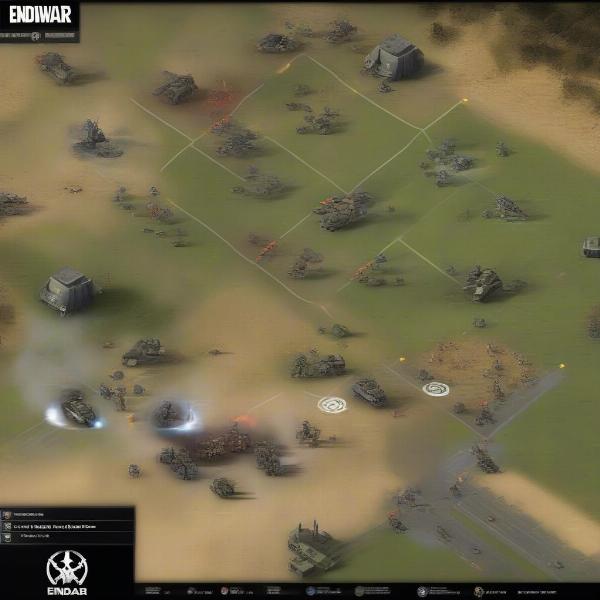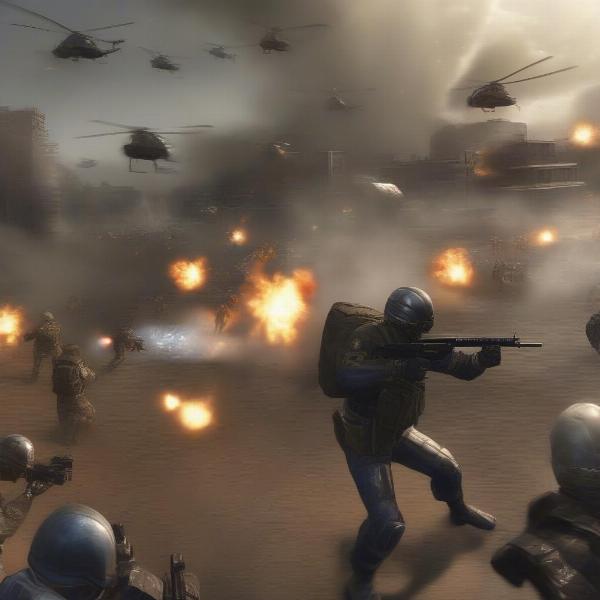Welcome to SupremeDuelist.blog, where we dissect the intricate world of strategy games. Today, we’re turning our attention to a title that, while perhaps not as widely discussed now, left a significant mark on the genre: Tom Clancy’s EndWar. This real-time strategy game offered a unique take on tactical warfare with its voice command system and global conflict setting. This article will explore the gameplay mechanics, the historical context and impact, and why this gem still holds up for strategy enthusiasts today.
We’ll delve into the core gameplay, highlighting its innovative features. Then, we’ll analyze its historical setting and how it impacts the narrative and tactical decisions. Lastly, we’ll examine its lasting influence on the RTS genre and provide a conclusive look at why fans still talk about it with such fondness.
Core Gameplay Mechanics of Tom Clancy’s EndWar
Tom Clancy’s EndWar distinguished itself with its innovative approach to real-time strategy, moving away from traditional base-building to focus solely on tactical battlefield control. The game features three factions: the US Joint Strike Force, the European Enforcers Corps, and the Russian Spetsnaz Guard Brigade, each with unique unit compositions and playstyles.  EndWar Tactical Gameplay showing faction units in combat
EndWar Tactical Gameplay showing faction units in combat
Instead of resource gathering and construction, players manage their forces directly on the battlefield, capturing control points to earn reinforcements. The voice command system, a key innovation for its time, allowed players to issue orders using voice commands, adding a layer of immersion. This mechanic was groundbreaking, allowing for quick, hands-free adjustments during hectic engagements. However, the game also features a traditional control scheme that players can switch to easily. The rock-paper-scissors style unit balance creates a strategic depth and promotes strategic planning.
Unique Unit Specializations
Each of the three factions boasts distinctive unit specializations, encouraging players to adopt different strategies. The US Joint Strike Force relies on high-tech units and powerful air support. The European Enforcers Corps excel in balanced attacks with strong infantry and durable vehicles. The Russian Spetsnaz Guard Brigade utilizes heavy armor and overwhelming firepower.  Russian faction units detailed in EndWar game
Russian faction units detailed in EndWar game
- US Joint Strike Force: High-tech units, advanced air support
- European Enforcers Corps: Balanced attacks, strong infantry
- Russian Spetsnaz Guard Brigade: Heavy armor, overwhelming firepower
The battlefield is divided into multiple zones, each with a specific strategic objective. Capturing these zones grants tactical advantages and allows players to deploy reinforcements. Players must maintain a solid supply line to avoid being overwhelmed. The ability to upgrade units and equip them with special equipment adds another layer of tactical depth to the game.
The Historical Context and Narrative Impact
Set in a near-future 2020 after a global oil crisis, Tom Clancy’s EndWar presents a world on the brink of war. The game’s narrative explores the tensions between the three major global powers as they vie for resources and influence, echoing real-world geopolitical concerns. The narrative provides a compelling backdrop for the conflict, grounding the strategic gameplay in a believable setting. “The beauty of EndWar lies in its plausible setting,” states Dr. Evelyn Reed, a military historian, “it takes current geopolitical tensions and projects them into a near-future conflict, making the game both entertaining and thought-provoking.” The game’s campaign mode allows players to experience the conflict from each faction’s perspective, offering a comprehensive understanding of the unfolding global crisis.
Immersive Storytelling Through Faction Perspectives
Each faction’s campaign provides unique narratives and perspectives on the global conflict, adding depth to the overall experience. The US campaign portrays their efforts to maintain world order, the European campaign highlights their struggle for autonomy, and the Russian campaign demonstrates their ambition for global power. These interconnected narratives offer a detailed view of how each faction interacts with and influences the other. “EndWar succeeds in presenting a balanced view of the conflict,” says Captain Marcus Thorne, a former military strategist, “each faction has its own motivations and goals, which creates an engaging and realistic scenario.”  EndWar game showing the world map indicating active war zones
EndWar game showing the world map indicating active war zones
The game masterfully combines its strategic gameplay with a narrative-driven campaign, making it more than just a tactical wargame. The cutscenes and in-game dialogue reveal the human side of the conflict, highlighting the consequences of strategic decisions. The game’s focus on realistic military technology and strategic depth gives a unique experience in the RTS genre.
EndWar’s Influence and Lasting Legacy
Despite not reaching the mainstream success of other strategy games, Tom Clancy’s EndWar left an indelible mark on the RTS genre. Its innovative voice command system, while not a ubiquitous feature in subsequent games, remains a memorable highlight. The game’s focus on tactical battlefield control over base management influenced the development of other strategy titles.  EndWar Units in fierce combat with explosions The game’s emphasis on strategic positioning and unit specialization forced players to consider more than just overwhelming their opponent with numbers.
EndWar Units in fierce combat with explosions The game’s emphasis on strategic positioning and unit specialization forced players to consider more than just overwhelming their opponent with numbers.
Why EndWar Still Resonates
The blend of realistic military technology, tactical gameplay, and compelling narrative continues to resonate with fans of the genre. Its detailed representation of modern warfare, combined with a touch of near-future speculation, creates a unique gaming experience. Even though the game was released in 2008, its strategic depth still provides a challenging experience for veteran RTS players. The detailed unit models, the realistic sound design, and the unique voice command feature create an immersive and engaging wargame experience. The game’s relatively small but devoted fanbase is a testament to its innovative design and lasting appeal. It proves that quality gameplay mechanics can stand the test of time.
Conclusion: A Tactical Classic
Tom Clancy’s EndWar remains a significant title within the real-time strategy genre, despite its limited current popularity. Its voice command mechanics, combined with detailed unit management and strategic gameplay, offered a memorable experience. Its compelling narrative and focus on realistic warfare elements contribute to its lasting appeal. Here at SupremeDuelist.blog, we recognize EndWar as a testament to the innovation and engaging gameplay found within the strategy genre. Give it a try or revisit it, you might find yourself lost in a strategic conflict. We encourage you to explore our other content on classic and contemporary strategy games. Keep playing, and keep strategizing.
Leave a Reply